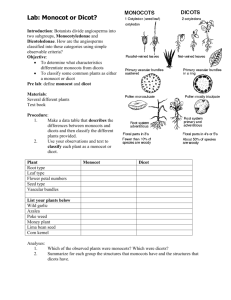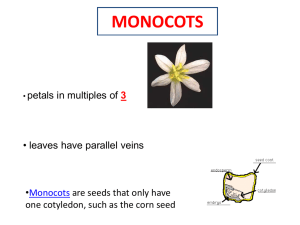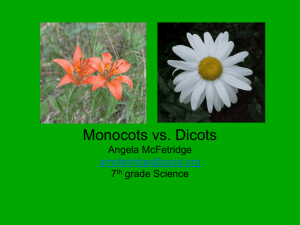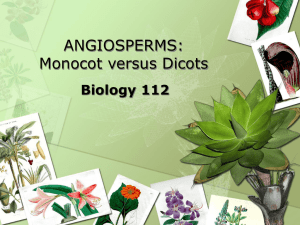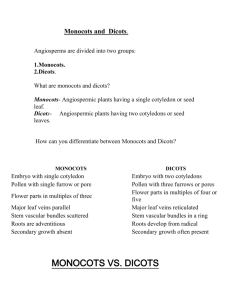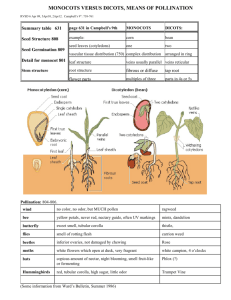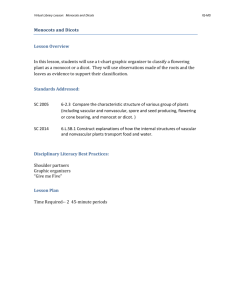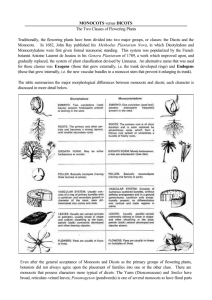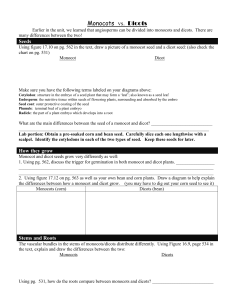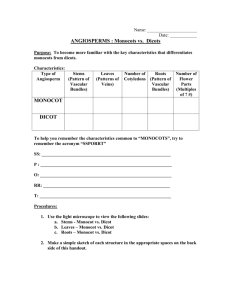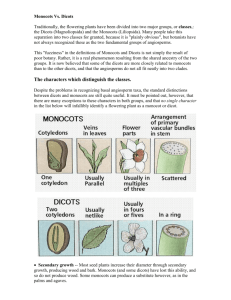Lesson - Colorado FFA
advertisement
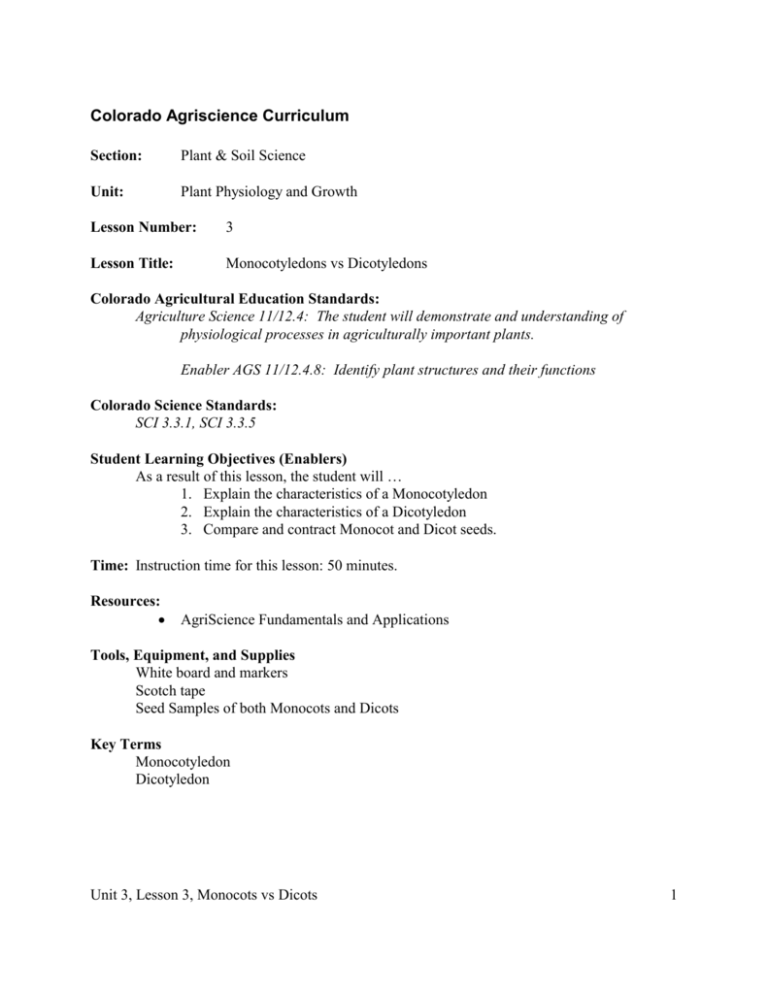
Colorado Agriscience Curriculum Section: Plant & Soil Science Unit: Plant Physiology and Growth Lesson Number: 3 Lesson Title: Monocotyledons vs Dicotyledons Colorado Agricultural Education Standards: Agriculture Science 11/12.4: The student will demonstrate and understanding of physiological processes in agriculturally important plants. Enabler AGS 11/12.4.8: Identify plant structures and their functions Colorado Science Standards: SCI 3.3.1, SCI 3.3.5 Student Learning Objectives (Enablers) As a result of this lesson, the student will … 1. Explain the characteristics of a Monocotyledon 2. Explain the characteristics of a Dicotyledon 3. Compare and contract Monocot and Dicot seeds. Time: Instruction time for this lesson: 50 minutes. Resources: AgriScience Fundamentals and Applications Tools, Equipment, and Supplies White board and markers Scotch tape Seed Samples of both Monocots and Dicots Key Terms Monocotyledon Dicotyledon Unit 3, Lesson 3, Monocots vs Dicots 1 Interest Approach Today I will need your best thinking! Display PP Slide 2. Raise your hand if you can tell me what the word on the screen means. If half of the class has their hands raised ask them to pair up with someone who does not have their hand raised. Their task is to use hints to help the other student understand what a cotyledon is without telling them directly. If very few have their hands raised, click the mouse twice and explain that these are hints to help them guess what cotyledon means and how it relates to plant science. Provide hints to them…for example distribute some corn and soybean samples and ask them to describe what is similar and what is different! Discussion should lead to…PowerPoint Slide 3. Ask the students to capture the following in their notes. • A cotyledon is the fleshy structure within a seed that contains food for a developing embryo. • Depending on the plant species, a seed may have one or two cotyledons. Monocots and Dicots grow differently and require different management practices so we need to be able to tell the difference! That is what today is all about. Summary of Content and Teaching Strategies Objective 1. Explain the characteristics of a Monotocyledon Explain to the students that we are going to begin with Monocots. Show PP Slide 4 and use the Little Professor Moment to capture the info in the student’s notes. • A. A plant species producing seed with one cotyledon is a monocotyledon, or monocot. – 1. All grasses are monocots. Corn, wheat, oats, Bermuda grass, and sugarcane are examples of monocots. – 2. Monocot plants have long, narrow leaves with parallel veins. All leaves branch from the main stem. – 3. Stems are non-woody and tend to have a large area of pith in the center. After the student instruction part of the Little Professor Moment, ask the students to draw an example of a Monocot beside the text their notes . Objective 2. Explain the characteristics of a Dicyledon Continue with the Little Professor Moment with the students switching roles to provide the information on Dicots using PP Slide 5. Unit 3, Lesson 3, Monocots vs Dicots 2 • B. A plant species producing seed with two cotyledons is a dicotyledon, or dicot. – 1. All plants other than grasses are dicots. Soybeans, trees, lettuce, sunflowers, and petunias are examples of dicots. – 2. Dicot plants have broad leaves with a net-type of veins. – 3. Stems are often long and branching. They may be woody or non-woody, depending on the plant species. After the student instruction part of the Little Professor Moment, ask the students to draw an example of a Dicot beside the text their notes . Objective 3. Compare and contrast Monocots and Dicots & Review/Summary For this comparison, direct the students to pair up and quickly and quietly decide which one will be the monocot and which one will be the dicot. After they have decided, explain that they will now be participating in a Marcel Marceau Moment. They need to create mime-like actions that show how they are different from each other. Allow 5-10 minutes for them to create their actions. Then ask for volunteers to share their mimes. Continue to allow the students to share highlighting the key differences. Congratulate the students on their mastery of the material. Application Extended classroom activity: Create a poster highlighting the differences between a monocot and dicot FFA activity: Prepare an activity to present at the next FFA meeting to teach the differences to the chapter. SAE activity: Look at the seed involved in their operation and determine which they are. Unit 3, Lesson 3, Monocots vs Dicots 3
